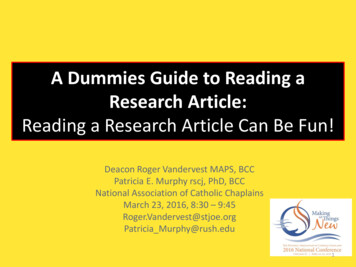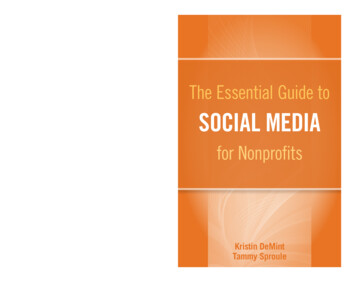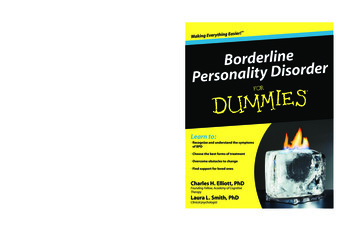
Transcription
A Dummies Guide to Reading aResearch Article:Reading a Research Article Can Be Fun!Deacon Roger Vandervest MAPS, BCCPatricia E. Murphy rscj, PhD, BCCNational Association of Catholic ChaplainsMarch 23, 2016, 8:30 – 9:45Roger.Vandervest@stjoe.orgPatricia Murphy@rush.edu1
Roger and Pat2
Why Did You Come?3
Goals and ObjectivesAfter participating in this workshop participants will beable to: Critically read research and where appropriate applythe findings in their professional practice. Describe what patient satisfaction means Name the two chaplain behaviors best related to asense that– spiritual needs were met?– that emotional needs were met. To name practical ways that chaplains can use theinformation in this article.4
The Correlates of Chaplains’Effectiveness in Meeting theSpiritual/Religious and EmotionalNeeds of PatientsFlannelly KJ, Oettinger M, Galek K, BraunStorck A, Kreger R. J Pastoral Care Counsel.2009 Spring-Summer;63(1-2):9-1-15.5
The Correlates of Chaplains’ Effectiveness inMeeting the Spiritual/Religious andEmotional Needs of Patients Correlates Spiritual/Religious Needs Emotional Needs Patients6
Why is Reading Research Important? Justification Evidence Based #1 Reason– Research Can Help Us Improve Our Care!7
Reading Articles The title! Introduction– Background– Aim or hypothesis (sets the GPSsystem) Methods– Tells the reader how we will get there Results– Tells the reader if we made it or whatwe found Discussion Your own thoughts Clinical Application8
Kevin Flannelly Sets Us on the RoadStudy Aim: The survey wasdesigned to assess not only thedegree to which patient’s needswere met, but, moreimportantly, to assess thedegree to which “satisfaction”with several chaplaininterventions contributed topatients’ perceptions that theirspiritual/and or emotionalneeds were met. p. 2Kevin Flannelly et al., 2009, p.10029
Methods for Quantitative Research You measure a quantity with Supposing we asked people in this study: “Are you at ahospital in New York City?” What answer would we get?pretty boring One of the things we will measure is satisfaction with thechaplain. The patients have the option of four rankedchoices. Will answers all be the same?Measures with a variety of answersare called variables.10
Types of VariablesPretestPretest Question: Label the picture as categorical, ordinal, or scale.11
Statistics InterludeDescriptive Easy things to count– Number– Percent Counting lots of possiblescores, like ages of peoplein your hospitalAssociationsSimilar ratings Chi-square Correlation– Bivariate– Multivariate– Average (Mean)– Standard deviation (SD)– MedianEarlySessionCoffeeHappychaplains12
Probability for the Intuitive PersonProbability of winningPublishers’ Clearing House;1 in 1.7 billion or.00000017Probability of having twins.0035Probability of getting aspeeding ticket this year.21613
Extreme Results in Statistical TestsIf the results of astatistical test areextreme, and theresults have aprobability of .05 orless, statisticians say theresults are significant(not just the result ofchance).14
Which p-value is the smallest?p 1. .042. 1.043. .584. .001Which p-value(s) indicates that theresults are not by chance? Hint: p .0515
Methods:SampleMeasuresProcedureDataAnalysis16
Sample: Who are the folks? NYCOrthopedic patientsShort length of stayResponded yes towanting pastoral care Median age 67 range22-92 64.5% were ts inNYC17
A QuestionWhich diagnosis is least likely to have the sameresponses?1. Cancer surgery2. Cataract surgery18
Procedures: Data Collection Answered “yes” to “want to see achaplain;” Volunteer conducted interview ina convenience sample within aday or two of being visited bychaplain; return rate 50% (120patients) Research assistant hired toconduct interview; randomizedsample; 131 contacted and all butone responded (130 patients)19
Dependent and Independent Variables20
Outcome Measures: Survey related to AimsSatisfaction (Outcome or Dependent Variable)– How well did the chaplain meet yourspiritual/religious needs?Not at all Slightly Moderately Very Well NA0123– How well did the chaplain meet your emotionalneed?Not at all Slightly Moderately Very Well NA012321
Survey on Demeanor:Independent VariableYes or no questions: 1, 0 Introduced himself/herself to the patient Seemed to care about the patient Spent enough time with the patient Provided privacy so patient felt comfortable talking Followed up with more visits (if patient wanted) Left a calling card (If patient wanted) Sat down while talking to the patient22
Satisfaction with (behavior):Independent variableScores 0 to 3 Really listen to patient Make patient feel comfortable Pray with patient Make hospitalization easier Tap inner strength/resources Help overcome fears/concerns Provide referral or other help23
Analysis: Focus is on AimsDescriptive– Mean and Median for ordinal measures– Number and frequency for “yes” or “no”questionsBivariate associations – correlationsMultivariate Associations - Regression24
Analysis: Focus is on AimsDescriptive– Mean, Standard Deviation(SD) and Median for“Needs Met” and“Satisfaction Measures”– Number and percent forDemeanor measuresAssociations Inter-correlations– How are the Demeanoritems related to eachother? (Table 4)– How are the Satisfactionitems related to eachother? (Table 5) Correlations– Needs met with demeanor( table 6)– Needs met withsatisfaction with chaplain’scare (Table 7)25
Results: Are we there yet?to assess the degree towhich “satisfaction” withseveral chaplaininterventions contributedto patients’ perceptionsthat their spiritual/and oremotional needs weremet. p. 226
Skewed Data27
Description for Dependent variableWhat was the possible range of scores?28
Description for independent variable:Demeanor29
Description for independent variable:Satisfaction with Chaplain CareWhat was the possible range of scores?30
CorrelationsIce cream and death?Click link and control to see Youtube.31
Glimpsing how to read correlations:A negative correlationNegativeReligiousCopingr -.29Age32
A positive correlationr .6533
Correlations go from -1 to 1Size depends on how close the points are to the line.A strong correlation r .83A weaker correlation r .3034
Table 5 is interestingWhat item is strongly correlated with helping the patient feel comfortable?35
Model with multiple correlatesS/R needs metMakepatient feelcomfortableHelpovercomefears36
Multiple Correlation Models37
What does it mean?Religious/Spiritual NeedsTwo behaviors to cultivate:Emotional needsTwo behaviors to cultivate:38
DiscussionStrengths:“Although patients’ spiritual needs and emotional needs are widelytreated as if they are one and the same (Clark et al., 2003), the presentstudy suggests that patients see them as being different.” (p10)Limitations:“Though the sample size is reasonable for these types of studies, alarger sample size would obviously be better, especially in light of themany patients who said several items did not apply to them. Thesample itself is somewhat unique in that it was drawn from a fairlyunique healthcare setting, i.e., a hospital that specializes in orthopedicsurgery.” (p.13)ImplicationsSome of these items might be a way to measure chaplains’effectiveness. Effectiveness is related to patients’ needs.39
What are your thoughts? Strengths Weaknesses Clinical implications40
A Dummies Guide to Reading a Research Article: Reading a Research Article Can Be Fun! Deacon Roger Vandervest MAPS, BCC Patricia E. Murphy rscj, PhD, BCC National Association of Catholic Chaplains March 23, 2016, 8:30 – 9











